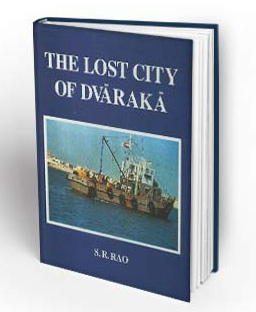
Prof. S. R. Rao, the renowned archaeologist conducted 12 search campaigns beneath the sea to search and reveal latent facts about ancient Dwarka from 1983 to 1990. His book titled ‘The Lost City of Dwarka’, released in 1999, created a hue and generated tremendous interest. Dr. Rao and his team with the help of modern techniques and underwater cameras have found out about ancient Dwarka. They have found two large structures on the seabed, one of which is near Bet Dwarka. The remains of a well-organized town have been found in the sea only half a kilometer away from the shore. The remains are in six parts containing places, stone–moulds for making weapons, instruments, iron-made weapons, etc.
The Mahabharata talks of ‘VaariDurg’ – a fort to stop water. Archaeologists have discovered the presence of such a fort. A seal is found which significantly has pictures of goat and bullock, etc. An ancient book ‘HarivanshPurana’ talks of a seal possessed by every citizen of Dwarka as a mark of identity. No outsider is allowed to enter without that seal. The Mahabharata talks of seven islands in the area. The satellite pictures of the topography of Okhamandal area testify the presence of such geographical islands. Evidence of an ancient time’s harbour are also found.
Anchors weighing up to 560 kilograms are found which were in vogue way back in 1500 B.C. in Syria and Cyprus. The remains also include two large titled stones used to launch a boat (techniques came into practice in 900 A.D.) certain pillars of the temple and copper utensils are found.
The utensils found from churning of sea near Dwarka carry inscription in Vedic Sanskrit. They are testified to be 3528 years old. Prof. Rao says since the sea near Bet Dwarka is muddy, going deep is not possible. Another two to five meter depth might give evidence of Dwarka set up by Lord Krishna himself, says Prof. Rao. The present Dwarka is the seventh edition, all others are deep sunk in the sea. This is why perhaps Bet Dwarka has an old temple of ‘Matsyavtar’ (fish-incarnation) of Lord Vishnu.
Dwarka’s remains too date back to those of the Harappan era found from Dholavira, Sur Kotada, Lothal. Prof. Rao concludes from his evidences that Krishna’s Dwarka existed since year 1700 B.C. at the far end of the Harappan era. That means the earlier conclusion about Krishna dating back to 3100 years B.C. during Vedic era before 5000 years doesn’t hold ground. That means we have to believe that Lord Krishna existed on Indian land only before 3500 years.
Ancient Dwarka from Archeological Point of View
Dwarka has been the centre of archeologists’ attraction all over. Samudranarayan and Varun Devata temple’s area on extreme left of the Gomati river have been very important from an archaeological excavation point of view. The mention of ancient Dwarka is found on a copper inscription of 574 A.D. This inscription is from Simhaditya, an executive of Maitraka’s of Vallabhi rulers. Simhaditya was the son of Varahdas, the King of Dwarka. Experts of Pune’s Deccan College had done some excavation in 1963. They had concluded that the first Dwarka’s establishment could be placed somewhere around the dawn of the Christine era but not before that. They had also inferred that studies confirmed the existence of the ancient Dwarka mentioned in Mahabharat and Skand Puranaetc at the same place.
If this observation is accepted, then it must be believed that the ancient Dwarka of Mahabharat dates back to Maurya era’s end. But this is far off from the hitherto accepted historical facts. On the contrary, from the Harappan habitats found in 20 kilometers area of Dwarka, Nageshwar and Vasai etc, it is certain that Dwarka existed in the last leg of the Harappan era or immediately thereafter. Okha Mandal, also known as Kushdwip, is distinguished from other parts of Saurashtra because of its desert. In fact, it is an island.

In order to remove congestion around the Jagat Mandir and monitor the activities around the temple, a two-story building was razed to ground. Excavation in the foundation of the razed building; unearthed a 9th century Vishnu temple, engraved pillars of a 12th century temple, its hall, and prehistoric remains etc. The excavation of 1979-80 thus confirmed Dwarka of 20th century prior to the Christ and confirmed the belief that habitat of the shore was engulfed by the sea 4000 years ago.
The present Dwarka is the eighth habitat and the present Dwarkaedheesh’s Jagat Mandir is the 5th one. The first habitat was submerged in the sea sometime in Fifteenth Century B.C. Similarly, the second habitat was also submerged in the sea in Tenth Century B.C. The first Dwarkadheesh temple was built in this era that was destructed due to sea-storms and second temple was built on the remains of the first temple. Third temple of Vishnu or Vasudev was built, when second temple was destroyed, in Ninth Century. The ceiling of this third temple was destructed due to sea storms sometime in Twelfth Century and only walls and seating place remained. Fourth temple was built thereafter. The existing temple is the fifth in series and the town is eighth habitat.
In Harivanshpuran, Dwarka is termed as vaari-durg (water-fort) or udadhi-madhyasthan (place in center of the sea). This indicates that Dwarka must have been an island once upon a time. Yadavas used to go to Bet Dwarka by boat. Bet Dwarka was Lord Krishna’s leisure spot.
Archeological Importance
Places of historical importance have an archaeological history behind it. The architectural values have changed over the past and hence it is even more important to preserve the values of the past. Let us have a look at the archaeological importance of the Dwarka temple.
“The sea suddenly leaped the shore and engulfed the whole town. The glorious buildings started submerging one after another in the sea. This happened at the spur of the moment. A lake replaced a whole town. No sign of a human habitat remained. Dwarka remained a name–sake, as a memoir.”
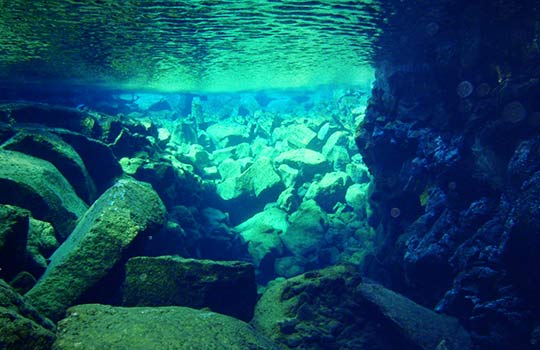
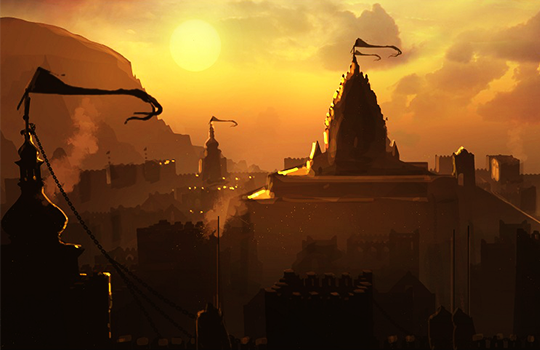
Suvarna Nagri
Dwarka, the headquarters of Okhamandaltaluka, is in the extreme west of the Saurashtra peninsula on the Arabian Sea. It is a station on the Ahmedabad-Okha broad gauge railway line, about 137-kms from Jamnagar, 217 kms from Rajkot and 378 kms from Ahmedabad.
Dwarka has been a centre of archeologists’ attraction all over.
Samudranarayan and Varun Devata temples area on extreme left of Gomati river have been very important from archeological excavation point of view. The mention of ancient Dwarka is found on a copper inscription
Bet Dwarka
The investigation of the Bet Dwarka island began in 1983, 1984 and 1985 A.D. subsequent to a survey of the shore in 1982. The fourth investigation was done in 1986 under the educational program of the University Grants Commission. The 30 to 35 meter tall rocks in Bet are covered with algae and thorny bushes. The bay in North and South of the eastern shore has a potential for safe anchorage. Ships are anchored at Balapar in monsoon near here. The temples viz. Dwarkadheesh, Neelkanth Mahadev, Dhingeshwar Mahadev, Shankh Narayan and Abhay Mata, etc. were built on the old places in the later part of the eighteenth century. In the third decade of the 20th century, Hiranand Shastri did some excavation behind Dhingeshwar temple and near Neelkanth temple.
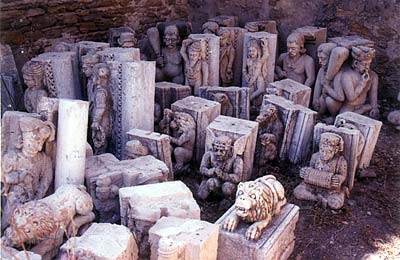
He found evidences of proto-historic habitat there. The earthen remains found there depict an inscription ‘Nandakdas’ in Brahmi script of the Mauryan era. It is therefore believed that this habitat must have been built in first or third century B.C. In 1950 A.D. also some work at Bet Dwarka was carried out. Thereafter in 1979-80 when the investigation started,the remains of earthen pots of last lag of Harrappan era were found from near Sidi Bawa Peer.
However, no evidence was found to prove that a town of the Mahabharat era was submerged there. But in 1982, a 500 meter long protection wall was found on the north of Sidi Bawa Peer. The wall is substantially damaged by the sea. Earthen pots of Red shining color were found from this place.
The significant remains found from this place include a porous pot, a mould for an iron pierce and a glittering-surfaced vessel. From the wall and remains, it could be imagined that Bet Dwarka was a port once upon a time and was destructed due to sea storms. During low tide, a large plate of 220 meters was found. A series of stones of 180 meter size were found from the shore towards the sea. They believed them to be of a submerged structure and certainly not drowned. Their shape suggests the use of these stones in constructing a 20 meter long wall. Stones of similar size were seen on the shore too. Balapar bay has become flat due to continuous sea-waves and the bay is formed near a Custom House and Dargah.
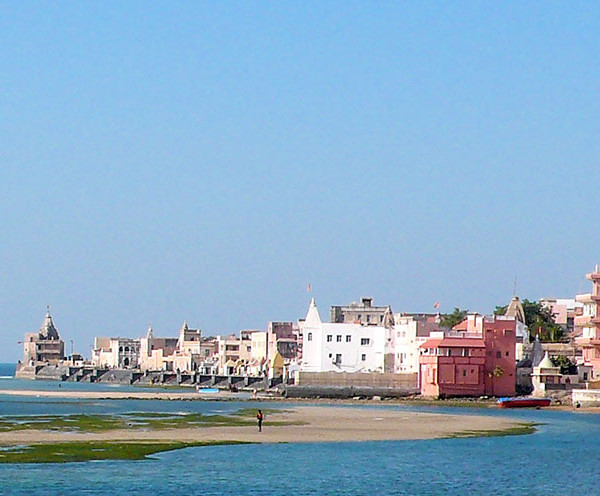
Dwarka Port
Of late, ships do not anchor at old port of Dwarkaor on the bank of Gomati river because of sand deposits. A stonewall built in 1990 also caused reduction in Gomati’s flow. Sea waves, on the other hand, bring about dirt deposits. While carrying out third expedition of investigation, silt and algae were removed from Samudranarayan temple to mid sea upto 200 to 700 meters. A navigation channel was noticed when cleaning was being done. Well-built lime stones of 1.5 x 1 x 0.5 and 1 x 0.75 x 3 meters size were also found. They are broken at places. Some of them still have a strong surface. It is difficult to say whether these remains belong to some structure or are of something else. A crescent shape and two stones found nearby lead to the belief about the existence of a temple.
Fourth expedition revealed that the stones found were damaged with tidal waters. They were buried under mud and bushes. In order to observe the masonry work, digging was done on both sides of the stonewall. Stone anchors having three holes, used in Cyprus and Syria, during the fourteenth to twelfth century B.C. were found.
During third and fourth expedition, some structure was found beneath the sea while digging with iron rods. During fifth expedition, a large size molded stone and a wall of the fort were found. Stones thus used in building construction were found from sea near Samudranarayan temple upto 600 meters’ distance.
This indicated existence of some construction there. It is presumed that in order to build a wall or the fort, construction workers must have solidified the seabed by dumping large sized stones. The majority of the mason-work is seen little above the seabed. It is crescent-shaped. Wooden pieces of a wrecked ship were found when digging was carried out here. An iron anchor was found while digging 1.5 meter deep in the sand bed at this place. A similar anchor was found earlier too. A 40 to 50 DWT ship could be easily berthed with these anchors. A seal, engraved pot and a stone mould of the Indus civilization can decisively throw light on the time when the sea engulfed Dwarka and Bet Dwarka.
The time derived from these remains and soil samples match. Another seal made from a seashell was also found. It was rectangular shaped. It contained a bullock with short horns, one horned horse and a goat engraved over it. It is certain that this seal belongs to the Indus civilization. The remains found near Bet Dwarka establish trade links between Bahrain and Bet Dwarka. The time Bet Dwarka assimilated in the sea was simultaneous with that of Bahrain. Subsequent to attacks by Shalva on Dwarka, a law was enforced under which a resident of Dwarka was required to have a seal of identity. Harivansh Puran also confirms this. A seal found from Bet Dwarka is believed to be belonging between 15th and 16th century B.C.
Thus, the sea around Dwarka is full of remains of sculptural and archaeological significance and hence lures scholars of history, archaeology, etc. equally.
(Courtesy: Abridged from and based on a prestigious volume entitled Progress and Prospects of Marine Archeology in India, by Dr. S. R. Rao).
Beneath the sea
“The sea suddenly leaped the shore and engulfed the whole town. The glorious buildings started submerging one after another in the sea. This happened on the spur of the moment. A lake replaced a whole town. No sign of human habitat remained. Dwarka remained a name – sake, as a memoir.”
Prof. S. R. Rao, the renowned archaeologist, conducted 12 search campaigns beneath the sea to search and reveal latent facts of ancient Dwarka during 1983 to 1990. His book entitled ‘the Lost City of Dwarka’ in 1999 created a hue and generated tremendous interest. Dr. Rao and his team with the help of modern techniques and under-water cameras have found out ancient Dwarka. They have found two large structures on the seabed one of which is near Bet Dwarka. Remains of a well-organized town have been found in the sea only half a kilometer away from the shore.
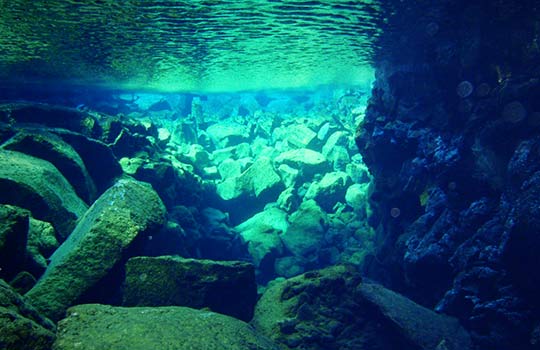
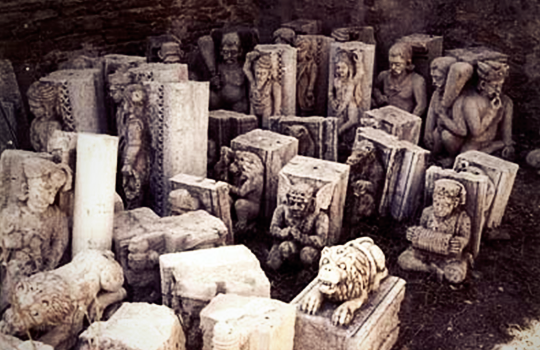
Discoveries by Archeologists
Mahabharata talks of ‘Vaari Durg’ – a fort to stop water. Archaeologists have discovered presence of such a fort. A seal is found which significantly has pictures of goat and bullock etc. An ancient book ‘Harivansh Purana’ talks of a seal possessed by every citizen of Dwarka as a mark of identity. No outsider is allowed entry without that seal. Mahabharata talks of seven islands in the area. The satellite pictures of the topography of Okhamandal area testify presence of such geographical islands. Evidences of an ancient time’s harbor are also found. Anchors weighing up to 560 kilograms are found which were in vogue way back in 1500 B.C. in Syria and Cyprus. The remains also include two large titled stones used to launch a boat, techniques came in practice in 900 A. D. Certain pillars of the temple and copper utensils are found.
The utensils found from churning of sea near Dwarka carry inscription in Vedic Sanskrit. They are testified to be of 3528 year old. Prof. Rao says since the sea near Bet Dwarka is muddy, going deep is not possible. Another two to five meter depth might give evidences of Dwarka set up by Lord Krishna himself, says Prof. Rao. The present Dwarka is the seventh edition; all others are deep sunk in the sea. This is why perhaps Bet Dwarka has an old temple of ‘Matsyavtar’ (fish-incarnation) of Lord Vishnu.
Dwarka’s remains too date back to those of Harappan era found from Dholavira, Sur Kotada, Lothal. Prof. Rao concludes from his evidences that Krishna’s Dwarka existed 1700 year B.C. at the far end of Harappan era. That means the earlier conclusions about Krishna dating back to 3100 years B.C. during Vedic era before 5000 years don’t hold ground. We have to believe that Loard Krishna existed on Indian land only before 3500 years.
